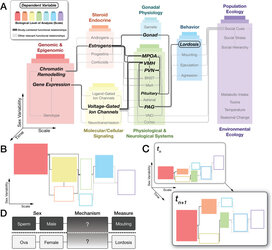In the A&N thread I posted an article about 24 troons complaining how science was leaving them behind. Some of them are computational biologists and speak with some degree of authority on their fields. Their dossiers were graciously compiled by AssignedEva, linked
here.
One of them was 'Miriam' Miyagi, who insists in a Harvard
editorial language must be changed to make it more trans inclusive:
“It’s really an abuse and a misappropriation of the authority of science to try to justify really regressive, harmful policy moves,” Miyagi said. “That’s why we feel that scientists have both a responsibility and a real opportunity to push back against this. When we say, ‘Calling transgender women biological males is not only insensitive, but it’s actually scientifically inaccurate in many ways,’ we’re able to take away one of these weapons in the arsenal of anti-trans activists.”
In their letter, the authors argue that scientists should explicitly define the usage of “male” and “female” in their research, as no single trait, such as chromosomes or genitalia, determines whether a person is singularly male or female. The boundaries between sexes has been found to be more complicated than that. “We have a responsibility to use precise language both as researchers studying sex-associated variables and as members of a diverse academic community,” the three wrote.
Here is 'Miriam':

He would like you to know he is NOT a male; that it's scientifically inaccurate to call him a male and that you are a goddamn bigot if you still think he is male.
Miyagi has written several articles for Cell,
one of which calls for 'sex contextualism' in research papers. Reminder that sex was only included as a variable as early as
2014. This troon is leading the push to have to abolished. So let's go through it.
Over the past 30 years, scientists and policymakers in the United States (US) and elsewhere have called for more attention to sex in biomedical research. The key arguments for this increased attention are two-fold: first, that consideration of sex is necessary to advance the health of women,1 and second, that factoring sex into research designs is required to ensure rigor, reproducibility, precision, and transparency in both clinical and preclinical research.2,3 It is often argued that without considering and understanding sex-related variation at the basic and preclinical level, flawed assumptions could be carried into clinical trials and ultimately clinical practice, which, coupled with the tendency to over-generalize from data derived from male models and datasets, could have particularly detrimental consequences for women.4 In other words, without adequate consideration of sex, the fear is that biomedical research could fall short of standards of rigor and precision, compromising its potential to advance health for all.
As a result of these calls to action, several funding bodies have introduced policies requiring the consideration of sex and/or gender throughout the research spectrum.5 One example is the Sex as a Biological Variable (SABV) policy of the National Institutes of Health (NIH) in the US. This mandate requires that NIH funded research include female and male animals/participants (unless a single-sex approach is clearly justified) and that findings be disaggregated by sex.6 Such policies are not limited to funding agencies; for example, many journals have adopted the Sex and Gender Equity in Research (SAGER) guidelines,7 which similarly recommend disaggregation of data by sex. Since these policies were implemented, consideration of sex and inclusion off male and male animals/participants in biomedical studies has become more common.8 A study of research proposals in Canada showed, for example, that between 2011 and 2019, the integration of sex into research designs increased from 22% to 83%.9 This finding suggests that the policies have likely increased the inclusivity of biomedical research. This increase has, however, occurred without concomitant emphasis on scientific rigor with respect to precise operationalization of variables, appropriate choices of analytical approaches, and accurate reporting.10–12 For example, a recent analysis showed that, in a sample of papers published in 2019, 70% of claims of sex-specific effects were not supported by appropriate statistical evidence.
Sounds pretty solid. Do you think Mr. Miyagi here will keep up this rigour?
Here, we discuss three main ways in which researchers can improve the precision and rigor of research involving sex categories. First, researchers can operationalize ‘‘sex’’ in ways that focus on concrete, measurable variables rather than relying on the proxy categories of female and male. Being specific about how these variables (for example, chromosome complement, hormone levels, or gendered social and environmental exposures) contribute to research observations can support causal hypotheses about the role of sex-related variation in health outcomes. This approach builds on the concept of sex contextualism,14 at the core of which is the observation that the relationship between sex-related factors and experimental outcomes will vary in context-specific ways across different research settings. Our argument also draws from the foundational work of others who have pointed out that sex is plurally defined and comprises multiple variables that can vary dynamically.15–19 Second, we call for enhanced rigor in research design and analytical methods in order to improve the accuracy of claims about the potential influences of sex-related factors, and to expand beyond ‘‘sex differences’’ alone as a means of describing and explaining variation. Third, we urge transparency and care in the reporting of findings and the generalization of results. Transparency relies on accurate accounts of the actual distributions of data and appropriate interpretation of any statistically significant difference between category means ;in addition, care should be taken when using findings about sex-related variation in laboratory models to make predictions about diverse and socially complex human populations.
Miyagi and his pals do not think sex is a concrete variable; that it is just a nebulous concept not defined by anything despite the introductory paragraph calling for it to be included in biomedical studies. We can see the political tint right away - these are troons using their scientific background to browbeat you into submission.
Studies of sex-related variation occur in a broader cultural milieu in which women and men are regularly constructed as opposites, gender inequities continue in both the public and private spheres, and sex and gender minorities face existential threats—precisely because they challenge deeply held convictions about the nature of sex categories.20 Scientific findings about sex-related variation filter into the public consciousness and can shape gender/sex stereotypes21 and attitudes toward minoritized groups.22 There is thus much at stake—for both human health and gender equity more broadly—in striving to uphold the highest scientific standards in the study of sex-related variation in basic science.
They are more concerned about stereotypes than they are about the facts. They want to uphold 'scientific standards', eh? We'll see about that.
In the years since funding agencies and journals began to introduce policies for the consideration of sex, it has become commonplace to refer to sex as a ‘‘biological variable.’’ As a starting point for situating sex-related factors in their context, we emphasize that sex is not a variable that is in and of itself a biological mechanism; rather, sex is better understood as a system of classification. Once assigned, sex categories are frequently treated as causal mechanisms, which is evident in claims that biological phenomena are ‘‘driven,’’ ‘‘influenced,’’ or ‘‘impacted’’ by sex.
Note how this troon jumps to the conclusion that sex is assigned, vs determined. And how it being a biological variable is put in air quotes, or the denial that sex has any impact on biological phenomena. Stunning work.
However, sex requires careful operationalization in order to move beyond a set of assigned categories such as female and male, and toward the actual mechanisms of interest. By acknowledging that it is not sex itself that generates effects in experimental settings, but rather any one (or more) of the mechanisms that assigned sex categories are taken to represent, we can be more precise about the relationships between biological variables and observed outcomes.17,23,24 Importantly, this approach can also allow for more accurate descriptions and explanations of overlap and similarity between sex-classified groups and the diversity and heterogeneity within them (Table 1). As an example, the use of the category ‘‘women’’ as a proxy variable—instead of the more precise variable of uterine presence/absence—underestimates incidence of uterine cancer in human populations by23%–53%andracialdisparities in cervical cancerby44%;it also obscures the incidence of these cancers in intersex and transgender people.25,26 In this case, adequately operationalizing sex beyond an identity or assigned sex category dramatically enhances the value of the data. The presence of a uterus is an example of how the use of sex-related variables relevant to the question at hand can result in a more precise operationalization of sex, including in basic research settings.
The troon wants 'uterine absence' to be used in this context, without knowing that it's only women who have a uterus. We have a uterus because of our reproductive type, you retarded troon. Shoving women out of the equation does not 'improve the data', you are just erasing them because you think it's a social construct.
Operationalization is particularly important when considering variables that correspond imperfectly with assigned sex categories. Hormone levels, for example, may correlate with assigned sex categories but can also vary independently of them. In most cisgender women early in the menstrual cycle or in post-menopause, estradiol levels overlap with those of cisgender men.38 In all people, regardless of sex assigned at birth, estradiol levels can vary in response to social context and behaviors as well as hormonetherapy39; this variation reflects the intersection of social factors (e.g., access to hormonal contraception, post-menopausal hormone replacement therapies, or gender-affirming care) with a sex-related variable.
"Hormones correlate to assigned sex categories"
"They can vary independent of them"
Then how are they correlated? Men and women having estrogen/estradiol does not change the fact women have more estrogen than men. Miyagi here knows - he takes it to make himself a 'true woman'.
"Sex depends on context":
Whether and how any sex-related variable matters—and what patterns of difference and variation it contributes to—cannot be assumed a priori, as these relationships will vary across research questions, model species, and lab settings.14 Consequently, researchers should consider which sex-related variables or covariates could be most relevant to the experimental setting at hand. When designing a study with the explicit aim of exploring sex-related factors, researchers should be aware that contextual factors such as age, environment, ovarian cycle phase, time of day, time of year, cell type, etc., each affect levels of hormones, gene expression, and other correlates of sex. The dynamic nature of hormone levels and gene expression dictates careful consideration of the tissues and time points that are sampled ,in the context of the goals of a given study.29,30,40 Similarly, other correlates of sex categories should be approached as highly context-specific.
"We need to stop using the crude terms male and female"
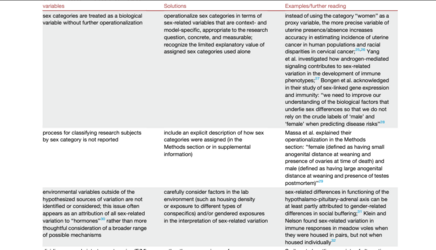
That's right. Instead of 'women' use 'absence of uterus/with uterus'. Totally humanizing, totally not erasing us.
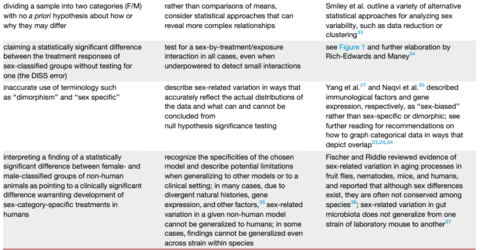
"Uhhh not every cell has a sex, sweetie."
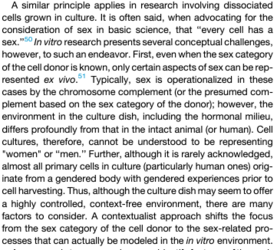
"A gendered body with gendered experiences." What is a 'gendered experience'?
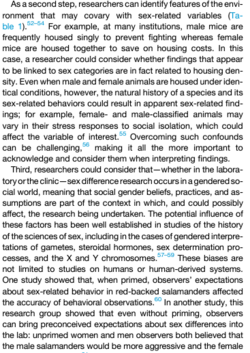

"Gendered interpretations of gametes"
"Biases"
Ho hum.
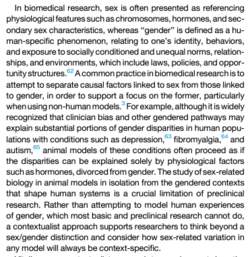
Yes, autism presents differently in males and females because of gendered expression - whatever the fuck that is. Genetics, take a hike - the troons have spoken.
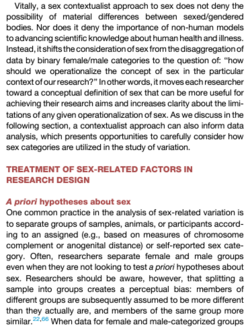
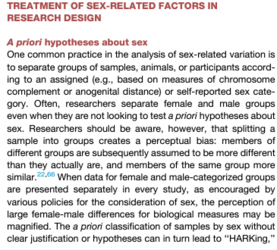
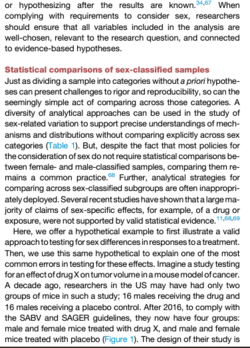
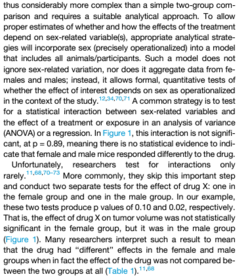
You ready for the banger? Get this: there are no sex differences in drug trials or medical research, because they are all false positives:
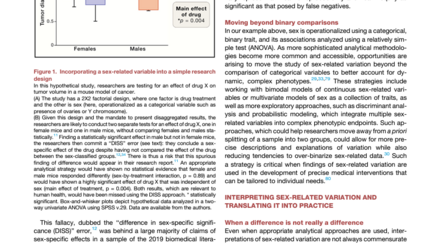
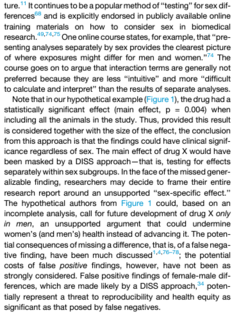
Okay, this paper got my heckles raised. I just decided to screenshot the rest of this BS in full vs snippets.

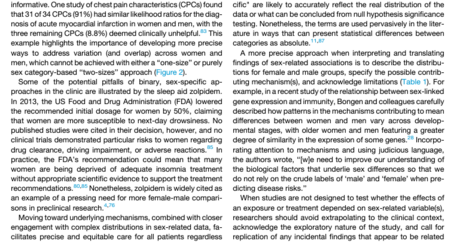
Here is their solution:
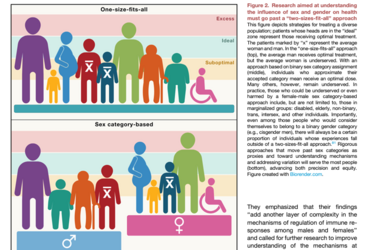
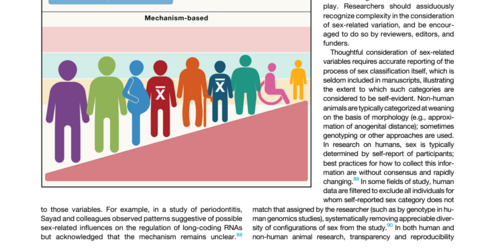
You got that? Sex variables don't exist, don't matter, and you should stop using them because they aren't accurate. We have the
same heart attack symptoms mind you. We're 100% the same.
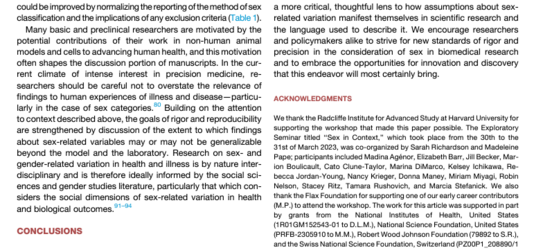
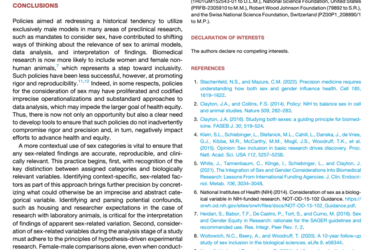

Interestingly enough, all those sex differences he says doesn't exist sure do show up in the papers he cites. He insists another framework must be used, because gametes, genetics, and chromosomes do not play a role. He wants some ill-defined concept based on bundled traits that are divorced from sex. Nearly all of the articles he references argue against that - and the few he referenced trying to buttress his claim do make a sensible take that in the push to highlight sex differences, some data is not reproducible. This is an issue in science in general and should be redressed.
Mr. Miyagi & co is also featured in a 'Who's Who' of troon researchers. That pdf is found
here.
Lil dood is very skilled at picking up sexism. She had to change her name to be taken seriously!
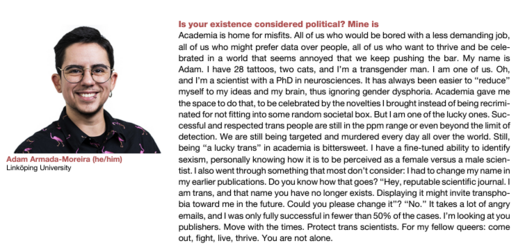
Another male says he has deep experience in chauvinism. Escapes it by 'becoming a woman', and gets a boost from the sisterhood:

Shattering stereotypes by acting like a stereotype. Lemme see those SAT scores.
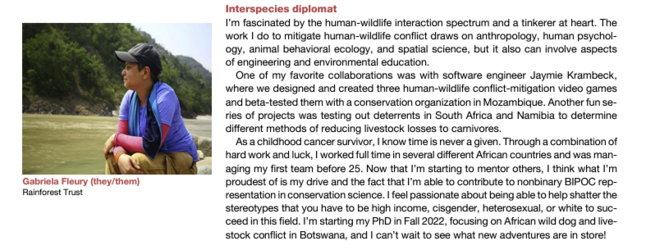
Now this one is by far the most credentialed out of all of them. Sofia has a very high
h-index, with 55,000 citations.
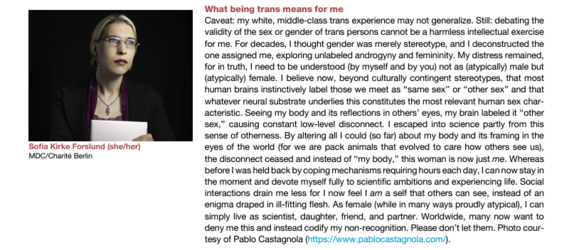
However, that does not stop me from rolling my eyes and looking at this very shooped photo and going, 'Yeah sure thing buddy, you totally disconnected from your male body because people kept clocking you.' I wonder why that is:

This was from a
talk he gave on the gut biome. Look at him and tell me if an actual female scientist could get away with what he's wearing:

But sure, bud, tell me how you deconstructed your gender with that man gut puffed out by estrogen and wearing clothes an actual woman would be called a 'sleaze' for.
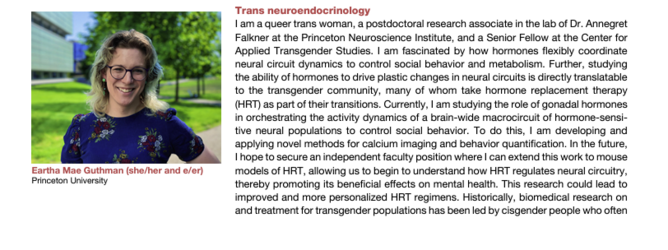
This boy can't wait to test HRT in mice. I bet it'll make their maleness go away like that Adam's Apple.
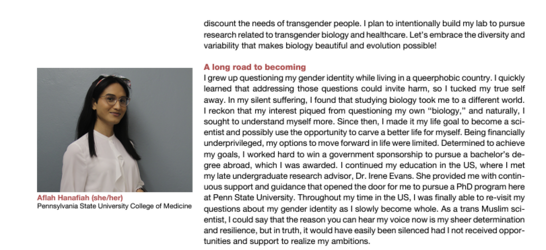
Pooner is upset gays get all the attention:
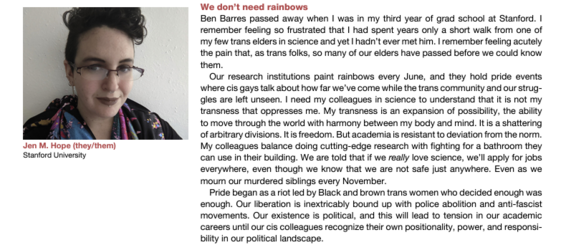

Another lil dood that we 100% cannot clock:
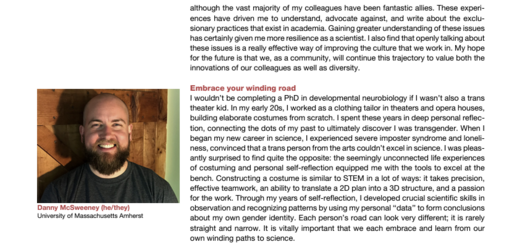
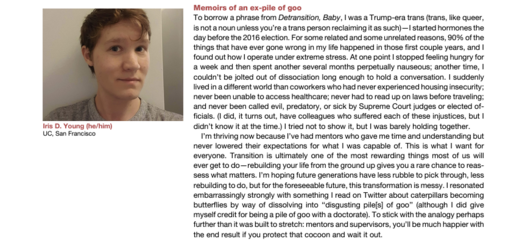
Such a whimsical little group. They are really proving that 'they will grow out of it once they enter the real world' mantra wrong.
Going back to Mr. Miyagi, he has a
Letter to the Editor demanding gender neutral language:
Inclusive language around sex diversity has never been more important. In the 5 years since the National Institutes of Health’s notice that proposals address sex as a biological variable (
1), the sociopolitical climate has become dangerously hostile to transgender and gender-diverse people. In the United States, a record number of anti-trans bills were proposed this year, and gender-affirming healthcare faces record wait times and unprecedented legal challenges in the United Kingdom (
2). Science can seem far removed from the struggle for transgender equality, but scientific language directly affects trans-focused rhetoric and policy (
3–
9).
It is important to recognize the context-dependent and multidimensional nature of sex. Rather than privilege any characteristic as the sole determinant of sex, “male” and “female” should be treated as context-dependent categories with flexible associations to multiple variables (such as, but not limited to, genitalia, gametes, or karyotype). The usage of “male” and “female” should be explicitly defined in any given study (
10). F
ailing to do so promotes harmful language (such as “male chromosomes” rather than “Y chromosomes”) that attributes an essential “maleness” or “femaleness” to traits, obscuring the true biological mechanisms at work (e.g., the Tdf gene leads to testicular development, not to “being male”). No one trait determines whether a person is male or female, and no person’s sex can be meaningfully prescribed by any single variable.
Testicular development ONLY happens in males, that's why it is part of the MALE reproductive pathway. Someone had another nuclear bomb dropped on them in utero.
Awareness of the distinction between sex and gender is another vital element to inclusive, quality research (
11). Conflating the two harms and invalidates gender minorities by implying that these distinct attributes are inextricably linked. It is in this context that many US states require surgery or sterilization before a person can change their gender on legal documents. We have a responsibility to use precise language both as researchers studying sex-associated variables and as members of a diverse academic community.
As scientists, we must push back against the misappropriation of biological terms by promoting precise language that focuses on the variables themselves (e.g., “menstruating people”) and acknowledging that people express these variables in ways that may not conform with a binary system of sex or gender. This both creates a more inclusive environment for gender-diverse scientists and reinforces that sex is a context-dependent summary of a multidimensional variable space.
That's right: PRECISE LANGUAGE means eliminating the word 'woman', because according to troons, 'woman' is an abstract principle with no defining traits. Of course, do not ever call Miyagi a PROSTATE OWNER, that wouldn't be 'precise language'.
I cannot imagine why it's women who need to be called 'menstruating people' or 'birthing bodies', while males retain all their language. Miyagi doesn't want to be seen as a 'biological male', yet wants the word 'woman' to himself. Typical troon logic.
Simone Sun, another bald-headed MTF tranny, proudly posted
his work on declaring the sex binary dead. Science Direct is far more forgiving on copy-and-paste, so it'll format much better.
We start with the usual 'sex isn't binary because there is variation in animals' argument:
Sex is ubiquitous and variable throughout the animal kingdom. Historically, scientists have used reductionist methodologies that rely on
a priori sex categorizations, in which two discrete sexes are inextricably linked with
gamete type. However, this binarized operationalization does not adequately reflect the diversity of sex observed in nature. This is due, in part, to the fact that sex exists across many levels of biological analysis, including genetic, molecular, cellular, morphological, behavioral, and population levels. Furthermore, the biological mechanisms governing sex are embedded in complex networks that dynamically interact with other systems. To produce the most accurate and scientifically rigorous work examining sex in
neuroendocrinology and to capture the full range of sex variability and diversity present in animal systems, we must critically assess the frameworks, experimental designs, and analytical methods used in our research. In this perspective piece, we first propose a new conceptual framework to guide the integrative study of sex. Then, we provide practical guidance on research approaches for studying sex-associated variables, including factors to consider in study design, selection of model organisms, experimental methodologies, and statistical analyses. We invite fellow scientists to conscientiously apply these modernized approaches to advance our biological understanding of sex and to encourage academically and socially responsible outcomes of our work. By expanding our conceptual frameworks and methodological approaches to the study of sex, we will gain insight into the unique ways that sex exists across levels of biological organization to produce the vast array of variability and diversity observed in nature.
Oooh sounds fun!
Sex is ubiquitous in the kingdom
Animalia and has long captured the curiosities of both scientists and non-scientists alike. To study sex, scientists have historically defined “sex” as a binary categorical variable, in which organisms are designated as either
female or
male based on an observable (or set of observable) characteristic(s) associated with
gamete type.
However, it is becoming increasingly clear that two discrete sexes are insufficient to capture the sex diversity observed in nature. Indeed, many organisms – including humans – show an immense range of sex variability that supersedes binary categories. This complexity is due, in part, to the fact that sex is observable across many levels of biological organization, including genetic, molecular, cellular, physiological, behavioral, social, and ecological levels, which may or may not be congruent with one another. Conceptualizing sex as a discrete binary is further complicated by the reality that mechanisms governing sex are embedded within complex biological networks, both affecting and being affected by other interconnected systems. We consider it within the purview of neuroendocrinologists to describe and model such complexity; however, it remains common practice to operationalize sex as strictly a binary variable, in our field and beyond. In addition, how we assign sex in our work is typically based on one defining characteristic, axis, or proxy of sex (e.g., chromosomes, genitalia, or plumage), which is constrained by the qualities that we (as human researchers) can observe and define as belonging to said sex category. We argue that to produce the most accurate and scientifically rigorous work examining the diversity and variability of sex, we must reconsider and advance the predominant frameworks, model systems, and analytical methods we are using to fully encompass the range of sex and its biology in animal systems.
Yes, they are using the clownfish argument. Shocker.
The goal of this paper is to challenge how we conceptualize, frame, and use “sex” throughout our work to improve our research output while engendering a more inclusive and equitable scientific society. We acknowledge that sex is a multifaceted, complex phenomenon that consists of many intersecting variables and can be approached from different perspectives. It cannot be overstated that we do not claim to have all the answers, nor do we purport to have a universal solution to these issues. Rather, we hope this perspective piece sparks constructive conversations on how to best approach this subject in our labs, classrooms, and scientific societies, each with their own unique contexts. We encourage readers to keep an open and critical mind to identify aspects of this perspective piece that are relevant to their own research, while remaining aware of the sociopolitical impacts of this work, particularly on marginalized communities. If sex is not a part of their research, we still invite readers to apply these concepts to improve their critical evaluation of research on sex and to increase awareness of sex variables that may be relevant in their own studies.
Simone himself said he was 'debunking' the sex binary with his paper, so this little disclaimer is moot.
At its most broad, sex refers to a form of biological reproduction characterized by the recombination and division of parental genomic material that is unified in the next generation. Sex also refers to a summary category of individuals within a sexually reproducing species (i.e., males, females, hermaphrodites).
Hermaphrodites are not a separate sex. They are called that because they possess the traits of both sexes.
In practice, these categories are assigned to individuals based on traits assumed to be associated, to varying degrees, with the production of haploid
gametes that differ relatively in size: the larger “female” ova and the smaller “male” sperm.
Note the air quotes here.
Classically, this categorization is then extrapolated to encompass other traits across different biological scales, or
Levels of Analysis3 (
Table 1), without consideration of timing for the development, emergence, and maintenance of sex variable traits.
This essentialist conceptualization of sex reduces all sex variable biology – development, genetics, anatomy, physiology, endocrinology, neurobiology, behavior, and ecology – to asymmetric gamete production (anisogamy) and privileges successful fertilization as a measure of fitness.
Actual science is hard. Lehtonen is considered one of the big-wigs in anisogamy. Shame to see his work slandered like this.
While this definition of sex may be useful for modeling generalizable principles of sexual selection (
De Vries and Lehtonen, 2023), it is overly deterministic in that it assumes anisogamy is ultimately causal for variation and diversity in sex biology (
Fig. 1), including the genetics of gonadal determination, physiological and morphological divergences, behavioral and social differences, and sex roles (
Goymann et al., 2023). This categorical, binary operationalization asserts
a priori that sex differences arise from two distinct biologies within a species, as though “the two sexes” are complex machines with different mechanisms, or even as different as another species (
Richardson, 2010). Collapsing the complexity of sex into a binary variable operationalizes sex categories – “a sex” or “the sexes” – as forms or substances independent from the influence of time rather than emergent states of interacting variables engaging in dynamic
biological processes.
4 Herein lies the primary contention of this perspective piece: operationalizing sex as a univariate, binary, categorical variable is insufficient to reveal the biology of sex. If we assume the sexes are separate, we inevitably produce separate models: “Sex differences predict sex differences” (
Gowaty, 2018).
> Sex isn't binary because it doesn't include everything
> Denies the fundamentals of how sex came into being in the first place
Yep, sounds like a troon.
This paper is exceedingly long, and will have to have another post dedicated to it to discuss it further. But I will add these paragraphs:
Univariate,
a priori operationalizations of sex severely limit our thinking and understanding of naturally occurring sex diversity, and assuming there are
only two sex categories that span all levels of analysis is restrictive. Any variation observed outside of categorical archetypes is incorporated post hoc and are often interpreted as rare, exceptional, pathological, erroneous, ignored, or unimportant. These assumptions also bias data interpretation and encourage reports of spurious sex differences (
Garcia-Sifuentes and Maney, 2021;
Gowaty, 2018;
Patsopoulos et al., 2007). Furthermore, this approach inherently disregards any naturally occurring sex diversity, despite the reality that individuals rarely fulfill archetypal sex categories, thereby hindering translation and comparison across different sexual systems in the animal kingdom (
Bachtrog et al., 2014;
DiMarco et al., 2022).
Another consequence of this approach is that the historically binarized study of sex differences operationalizes “males” as baseline, whereas “females” are studied only in relation to males (Smiley et al., 2022; Massa et al., 2023). In the binary framework, the biologies of males and females are often considered so distinct that females are often relegated as a separate experimental condition or – as in some rodent studies – are studied following ovariectomy to control the influence of cycling gonadal hormones under the false pretense that endogenous hormone cycles cause increased behavioral variability (
Levy et al., 2023;
Shansky, 2019). The binary framework also overemphasizes an oppositional framing: if one variable value is male, then the other can only be female, precluding any applicability to animal sexual systems in which individuals can produce both, neither, or incomplete gametes. While the NIH initiative Sex as a Biological Variable (SABV) sought to remedy such systemic practices, it has not addressed the underlying fundamental issue of considering sex
only as a binary variable (
NIH, 2015;
DiMarco et al., 2022).
Simone Sun, a male, is shocked that females have different biology to males. Best to deny it anyways because the 'binary framework' is transphobic and wrong.
The “sex as a binary” framework also collapses the multi-level, multi-scale nature of sex (
McLaughlin et al., 2023), thereby flattening, erasing, and obscuring the influence of scale and time on sex biology. Many sex-associated traits have varying dynamics and occur at specific life stages, are influenced by developmental processes, or have effects seen later in life. Furthermore, these spatio-temporal properties can interact to produce sex variability (
McCarthy, 2023). For example, gonadal steroid hormones, such as estrogens, contribute to the expression of adult sex variable
territorial behaviors due to hormone surges during the
perinatal period, with sex divergent effects dependent on the expression of
enzymes in specific brain areas (
Wu et al., 2009). In order to better investigate how sex, sex diversity, and sex variability (
Table 1) arise from interacting variables spanning biological scale and time, a new, integrative framework that does not rely on categorical
a priori assumptions that ignore or flatten the multidimensional nature of sex is required (
Fig. 1A). Such a framework will enable scientists to describe sex differences with greater precision, incorporate instances of sex similarity without disregarding, oversimplifying, or overinterpreting results, and reduce reports of spurious differences. Ultimately, by centering sex variables and their scale-spanning relationships, this framework will guide studies toward identifying the specific biological mechanisms that generate sex variability and diversity.
> We want scientists to describe sex with greater precision
> Expresses shock and confusion females are different based on their biology
This'll be a ride. Oh, need I mention there's a graph?
